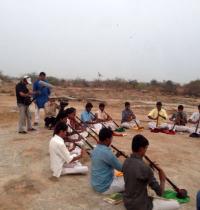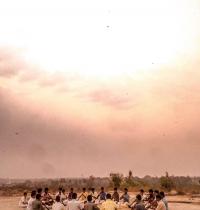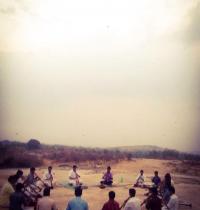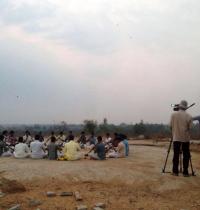Ashok Maridas
Grant Period: Over one year
This grant supports him to research into the struggles and transitions taking place within the community of Nadaswaram players, in relation to their music and social structures. Centered on the lives of three protagonists representing different generations, the film seeks to unravel the predicaments and negotiations that are currently taking place within the community in response to a drastically changing social and cultural milieu.
The Nadaswaram, a double reed wind instrument in South India, has traditionally been played by lower caste communities. In the Tamil region, it was mostly male members of the devadasi community that excelled in playing this instrument. In Karnataka, the players of the instrument have mostly come from the hajaama or the barber community. Considered a very auspicious instrument, the Nadaswaram till about a decade ago, used to have a place of pride in most auspicious events in upper caste Hindu families, especially during weddings. However, over the years, with caste identities becoming more and more rigid, the Nadaswaram players continued to be marginalised to the extent that word hajaama has today come to be used in a derogatory and abusive manner in reference to dalit communities.
Coupled with this social marginalisation, there has also been the gradual attrition of the use of the Nadaswaram itself, within the South Indian music context. The movement of music concerts from open spaces to the indoors, the coming of audio technology - especially microphones - and the hegemony of the human voice, have been a few of the many processes that have over the years, relegated the Nadaswaram to the margins. These processes have deeply dented the lives of the musicians in social, economic as well as artistic ways. The youth within the hajaama community is steadily withdrawing from their musical lineage. On the other hand, however, there is a rising political consciousness within the community that has been demanding a more dignified identity, through drive to rename themselves as the Savita Samaj instead of hajaama. In the barber families that still keep their connections with their music, the urge is to replace the Nadaswaram with the saxophone, which is more ‘respectable’ since its western origins are not weighed down by the baggage of caste histories. It is these complex phenomena - the transitions, the negotiations and the struggles that are currently taking place within the community - which the film seeks to understand.
Ashok’s own tryst with the Nadaswaram players began accidentally several years ago. Amidst much of his commercial work, he had continued to build his relationship with members of the community. This gave him an opportunity to study their everyday lives closely. The IFA grant comes to him at a very crucial juncture when the community is going through significant internal transitions. As Ashok says in his proposal, the film will be an ‘active record’ of the dialogue between two generations of the Savita community.
The film will be centred on two key protagonists, Rangappa and Lakshman. They hail from villages close to Bangalore and represent opposite, sometimes conflicting worldviews that are currently prevalent in the community. A third protagonist, Murthy, is the voice of the youth that is getting disenchanted with their musical legacy. Using the instrument as a visual metaphor, the film will explore the socio-economic issues that are influencing the sweeping changes in the lives of the community members and the agony of their loss of a great open-air musical school.
‘Considering that there is very little in the mainstream discourse about the Savita community and its connections to the Nadaswaram, it is important to ensure that at no point the voices of the community is allowed to get lost’, Ashok says in his proposal. While the Nadaswaram has been written about fairly extensively, there is almost nothing about the Savitas, their history, their current turmoil and their musical legacy. Without doubt, this film will significantly contribute to the existing discourse on the Nadaswaram in South India. A film will be the outcome of this project.
This grant was made possible with support from Titan Company Limited.




